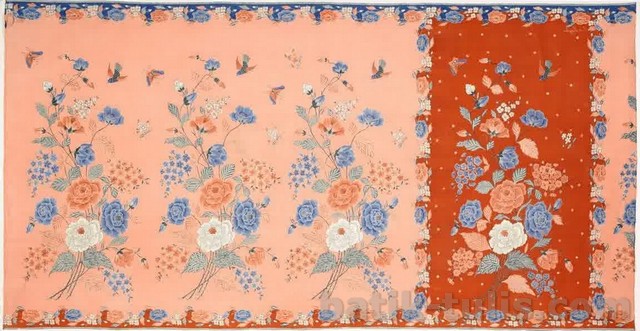Betawi Batik that we know today is a type of batik originating from the Jakarta area. If we trace the history of betawi from the VOC ( Dutch trading company) era which we can see through some old photos, at that time the city of Batavia or currently better known as Jakarta which is the root of Betawi culture, has developed a batik business at that time, but the enterpreneurs and batik craftsmen come from cities such as Pekalongan and Solo which are ready known as batik producers.
In the 19th century during the Dutch colonial period, there was one premium batik enterpreneur, namely Eliza Van Zuylen (1863 – 1947). This batik cloth made by Eliza Van Zuylen is only owned by very rich women because the price is very expensive. At that time salary of Dutch colonial goverment employees was approximately 20 guilders, and this sarong-shaped batik cloth, hereinafter commonly reffered to as Eliza Van Zuyten’s sarong, cost about thirteen guilders, which is equivalent to the current price of a Christian Louboutin chanel bag or shoe.
Eliza Van Zuylen’s Batik motif with a ‘bouquet’ style of batik with the main ornament of Eroupean-style flowers, batik cloth wrapped around the waist or Javanese people usually call it jarikan and combined with a blouse with fashionable lace or people now call kebaya. Batik motifs made to meet the tastes of Europeans, usually the atik cloth is brightly colored with naturalistic designs in the from of birds and flower arrangements with the trademark bouquets of flowers “buketan” and the batik wa produced in the city of Pekalongan from 1890 – 1946.

Based on the history above, we can say that in the past the Betawi people didn’t carry out batik activities as other regions such as Solo Batik, Cirebon Batik, or Pekalongan batik were able to make their own batik.
A writer such as Suwati Kartiwa in her title ” Batik Betawi : in a Creative Culture Perspective”, said that most likely the origin of Betawi batik came from the assimilation of Javanese people from coastal areas producing batik with Batawi people who fused, gathered and lived fro a long time at one place the environtment of the city of BAtavia then spread their culture in the from of batik cloth.
A long with the development of the era, the Betawi batik motif emerged by highlighting the Tumpal typical batik motif which has a triangular geometric shape that must be on the front. The image of the distinctive features of Betawi batik because it is the result of assimilation with Hokokkai batik, in my personal opinion.

The following are Betawi batik motifs after developing for so long, including:
- Betawi Batik Motif Loreng Ondel-ondel, this batik motif was created to lift the figure of the Ondel-ondel doll which is used as a repellent against reinforcements or in other terms we can say to keep away bad qualities. Often the Betawi batik motif is worn only at Betawi traditional ceremonies.
- Betawi Batik Nusa Kelapa motif, the batik motif was inspired by the Ceila Map which was made in 1482-1521 during the reign of King Siliwangi. It should be noted that the map shows that in the past, the city of Jakarta was named Nusa Kelapa, which was later renamed Sunda Kelapa, Jayakarta, Batavia, and finally Jakarta.
- Betawi Batik Ciliwung motif, the batik motif emerged on the basis of human civilization that began and developed from the banks of the Ciliwung River. The philosophy of batik has the hope that the wearer will have a strong attraction and is also worn as a symbol of fortune that will continue to flow like a river.
- Betawi Batik Rasamala Motif, the batik motif depicts the history of the VOC when it first entered the Sunda Kelapa area which was still a dense forest and still overgrown with Rasamala trees.
- Betawi Batik Salakanagara motif, the batik motif raised the theme of the first kingdom in Betawi land which was founded by Aki Tirem in 130 AD. The word Salakanegara is closely related to the beliefs of the people at that time who thought that the mountain had great power, namely Mount Salak, Bogor.
Currently, the Betawi batik motifs mentioned above are very difficult to find and we no longer find batik craftsmen with these motifs. If we want to see classic Betawi batik, then come to a cultural exhibition or a large Betawi traditional ceremony.
Bibliography of Betawi Batik
- Anonymous, The Meaning Behind Betawi Ancient Batik Motifs, Online http://radio.itjen.kemdikbud.go.id/ accessed at April 18, 2015.
- Eliza Van Zuylen, Discovering Eliza, online https://uncrated.wordpress.com/2015/03/25/discovering-eliza/ accessed at April 18, 2015.
- Asian Art Department, Batik sarong with bird and flower design, June 2003, Online: http://www.artgallery.nsw.gov.au/collection/works/202.203/ accessed at April 18, 2015.
Betawi Batik Pictures


